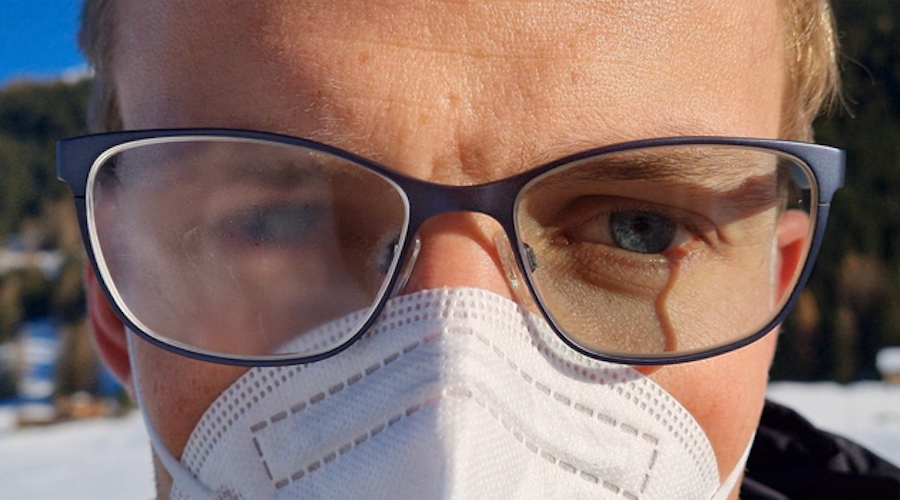Gold may be the solution to foggy glasses
Staff Writer | December 19, 2022 |

The left lens (right from the reader’s perspective) has the new antifogging nanocoating. The other lens is uncoated. (Image courtesy of ETH Zurich).
A recently developed ultrathin, gold-based transparent coating that is able to convert sunlight into heat is being proposed as a solution to prevent fogging in glass surfaces such as those in eyewear or windshields.

The soon-to-be patented coating has been created by researchers at ETH Zurich employing methods that are used extensively in manufacturing, such as vapour deposition under vacuum in a clean room to deposit minuscule amounts of gold onto the surface being treated.
The coating is made up of a single gold nanolayer and is significantly thin, which makes it transparent as well as pliable. Further, it absorbs infrared light selectively.
The new material also takes an approach that differs from conventional antifogging methods. Traditionally, surfaces are coated with water-attracting molecules, which results in an even spread of condensation. This is how antifog sprays work. But the new method instead heats the surface, thus preventing humidity-induced condensation from forming there in the first place. It’s the same principle as is used for a car’s rear window.
The problem with the way things are done in cars is that electric heating is required, which is inefficient and wastes energy. In contrast, the new coating is heated passively and requires, during the daytime, no additional energy source.
Tiny gold particles
The way the coating is designed involves minuscule, extremely thin clusters of gold sandwiched between two ultrathin layers of titanium oxide, an electrically insulating material. Due to their refractive properties, these two outer layers increase the efficacy of the heating effect. Moreover, the top layer of titanium oxide acts as a finish that protects the gold layer from wear. This whole “sandwich” is just 10 nanometres thick. By way of comparison, a common gold leaf is twelve times thicker.
The individual gold clusters touch each other minimally, which is what allows the gold layer to just start conducting electricity. So in the absence of sunlight, it would still be possible to use electricity to heat the coating.
“Our coating absorbs a large proportion of the infrared radiation, which causes it to heat up – by up to 8 degrees Celsius,” ETH doctoral student Iwan Hächler, who was a driving force behind the development, said in a media statement.
Given the positive results of their initial tests, Hächler and his colleagues will now develop the coating further for other applications. In the process, they will investigate whether other metals work just as well as gold.
They believe that in addition to eyewear and windshields, this antifogging method could be used wherever objects must be both heated and transparent – such as windows, mirrors or optical sensors.
Staff Writer | December 19, 2022 |

The left lens (right from the reader’s perspective) has the new antifogging nanocoating. The other lens is uncoated. (Image courtesy of ETH Zurich).
A recently developed ultrathin, gold-based transparent coating that is able to convert sunlight into heat is being proposed as a solution to prevent fogging in glass surfaces such as those in eyewear or windshields.

The soon-to-be patented coating has been created by researchers at ETH Zurich employing methods that are used extensively in manufacturing, such as vapour deposition under vacuum in a clean room to deposit minuscule amounts of gold onto the surface being treated.
The coating is made up of a single gold nanolayer and is significantly thin, which makes it transparent as well as pliable. Further, it absorbs infrared light selectively.
The new material also takes an approach that differs from conventional antifogging methods. Traditionally, surfaces are coated with water-attracting molecules, which results in an even spread of condensation. This is how antifog sprays work. But the new method instead heats the surface, thus preventing humidity-induced condensation from forming there in the first place. It’s the same principle as is used for a car’s rear window.
The problem with the way things are done in cars is that electric heating is required, which is inefficient and wastes energy. In contrast, the new coating is heated passively and requires, during the daytime, no additional energy source.
Tiny gold particles
The way the coating is designed involves minuscule, extremely thin clusters of gold sandwiched between two ultrathin layers of titanium oxide, an electrically insulating material. Due to their refractive properties, these two outer layers increase the efficacy of the heating effect. Moreover, the top layer of titanium oxide acts as a finish that protects the gold layer from wear. This whole “sandwich” is just 10 nanometres thick. By way of comparison, a common gold leaf is twelve times thicker.
The individual gold clusters touch each other minimally, which is what allows the gold layer to just start conducting electricity. So in the absence of sunlight, it would still be possible to use electricity to heat the coating.
“Our coating absorbs a large proportion of the infrared radiation, which causes it to heat up – by up to 8 degrees Celsius,” ETH doctoral student Iwan Hächler, who was a driving force behind the development, said in a media statement.
Given the positive results of their initial tests, Hächler and his colleagues will now develop the coating further for other applications. In the process, they will investigate whether other metals work just as well as gold.
They believe that in addition to eyewear and windshields, this antifogging method could be used wherever objects must be both heated and transparent – such as windows, mirrors or optical sensors.
No comments:
Post a Comment